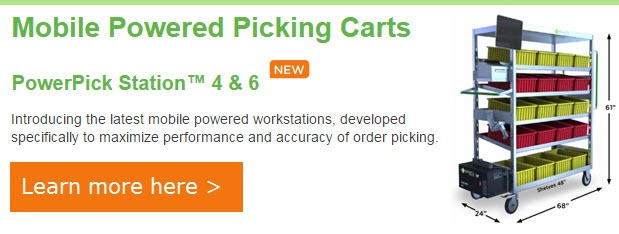
With warehouses and distribution centers (DC) doing more inventory and SKUs work, businesses are required to address orders for various channels. As a result, building a good inventory management system is becoming crucial and doing so becomes more complex. Here are some critical areas to focus on to deal with the multi-channel era.
DC managers are under constant pressure over the past few years to meet the growing e-commerce. In such a speed obsessed era, it is not about reducing the inventory, but control.
An upward trend in inventory
Last year, in the Unites States manufacturing and purchasing activities were on an upward trend. It wasn’t until November 2015 that the ‘Institute for Supply Management Report on Manufacturing’ showed a small cut in manufacturing activities, which is in fact the first result in 36 months. While the latest study indicates more contraction in inventories, the overall scenario is that it is still growing — and this means more inventories for managers.
DC operators are getting more SKUs (stock-keeping units) to manage and extra inventory turns. A recent study by Logistics Management under the title 2015 Annual Warehouse and DC Operations Survey reveals the average number of SKUs rose by at least 18 per cent in 2015, average annual inventory was 9, and 38 per cent of the respondents were planning on processing more SKUs in the future. In addition, the study finds 40 per cent of the respondents are now taking care of service on e-commerce channel, which is growing by 6 per cent since 2014.
In simple terms, the challenge today is how to properly manage inventory in a more precise manner to fulfill the needs of multi-channel fulfillment. Also, the cost efficiency is crucial, but it is in fact a dual challenge – utilize e-commerce opportunities and work at the lowest cost.
Top consultants who are working closely with logistics and supply chain executives have given insights on how your business can have better inventory management.
Under one roof
According to Ian Hobkirk, founder Commonwealth Supply Chain Advisors, for some businesses which are looking for multi-channel fulfillment efficiencies, the trend is to move away from distribution centres that are dedicated to a single product/channel and instead setup DCs that can fulfill orders for multiple channels.
The story that began ten years ago when there was significant channel separation has changed and retailers are now looking at having multi-channel fulfillment centers and an inventory that can meet all channels under one roof, he said.
Another senior consultant from St. Onge Company Don Derewecki says that the rise of omni-channel fulfillment centres makes inventory management much more complex. “This requires better systems which can be easily executed, forecast collaboration besides management reporting across multi-disciplinary collaboration,” says Don.
As you can see there are many factors involved in installing better control of inventory, here are the six best practices that will help your business manage inventory in a much leaner way, especially if you are facing multi-channel fulfillment complexities. These recommendations cover everything from the demand-planning stage to more recent solutions like distributed order management (DOM) which involves ground rules for optimal multi-channel fulfillment. We will also talk about time-tested inventory practices like capturing real-time data via scan validation.
1. Demand-planning attention
Better, but smaller inventories don't come about because you use better execution systems, says Derewecki. “In fact the process begins with a technology that can forecast demand and appropriately time that demand.” Most companies are equipped with modules in ERP systems or what is known as the best-of-breed demand planning applications which helps planners to come up with accurate forecasts. “However, the trick lies in how you disseminate that information to the supply chain team,” he adds.
Sales and operations planning processes and cross-functional teams are the medium for sharing inventory outlook and movements that are tied to forecast numbers, says Derewecki. Whether or not there is a formal Sales and operations planning process within a company, he claims, the development of effective cross-functional teams is really crucial for relaying forecast and promotions strategy to those who are responsible for outbound inventory and operations of DC.
In addition to the classic-demand planning / longer-range of merchandising and the product planning software, some supply chain vendors also offer things like businesses inventory optimisation or replenishment systems/tools that can process product level demand plans to translate them into more granular impacts at DC level.
As such, the best practice for you is not to simply share high-level product forecasts, but to break it down to something which is more meaningful for managers of DCs and logistics. Derewecki said: “The best inventory management starts with a tech system that can forecast demands vs your current state of inventory at SKU level.”

2. Setting Policy & executive buy-in
In theory, a DC which also functions as a multi-channel fulfillment setup would allow sharing of some inventory between channels in order to make up for the unexpected demand, the managers of such multi-channel DC first need to formulate policies for a virtual allocation of inventory.
A DC which has everything under one roof, but with different inventory systems or even office walls or similar barriers between storage and product order processing areas for each and every channel, cannot easily enjoy all the efficiencies of a properly integrated, multi-channel DC, says Hobkirk.
One of the biggest challenges is policy setting and then balancing the needs of other stakeholders. “It is true that different stakeholders in a given company can get really protective of the inventory,” Hobkirk said adding “some so called experts will say ‘never let just one channel steal the inventory.’”
So, where does the answer lies? The management must establish priorities for its multi-channel fulfillment and this can vary from company to company. Some businesses may prioritise wholesale orders just because they tend to have larger orders, while others would want to prioritise e-commerce over replenishment to the stores that they do control. “So, it all comes back to the basic idea of priority setting that really makes sense for your business and your distribution variables,” according to Hobkirk.
And according to Derewecki, it’s appropriately framing inventory management policy that ultimately defines your success levels. He feels that companies have to get top commitment from top officials when it comes to business policies and systems. “If your firm doesn’t have that, you don’t actually have much of anything.”
3. Distributed Order Management as ‘the brain’
It's true that not all companies with DC operations require a distributed order management (DOM) system, it's important to consider it if your company is dealing with omnichannel fulfillment challenges. The main benefit of DOM according to Hobkirk lies in its smart ‘brain’ if it is properly implemented. DOM can act like “a brain” for the your company’s complex rules that you applied to orders for fulfilling them in a way that meets your promise to the customers at optimal cost — while at the same time adhering to your inventory objectives.
DOM is really useful for companies which are trying to take decisions on whether they should fill e-commerce orders from a DC, a store, or in fact split fulfillment nodes for the orders. The rules that must be embedded in DOM can be pretty extensive, says Hobkirk, and that need to be counted in details such as whether a select store has the labour capacity to process e-commerce duties; or whether higher business margins for certain SKUs in urban stores, it may make better sense to fulfill certain orders directly from a DC even if the urban store is nearer.
4. Optimizing common bin centres
For a business that has many multi-channel fulfillment centres, leveraging common, forward-pick bins for most of the inventory can bring efficiency in labour and a better ability to share the inventory, according to Hobkirk. Even then there are some caveats in this approach, starting from enough similarity in order profiles across multi-channels.
For instance, when a wholesale order for an SKU is so large it would deplete the pick bin. In such cases, it may make perfect sense to pick the wholesale orders right from the overstock location. “So, it depends heavily on order profiles, but in general cases, picking an order from a common bin maximises the efficiency of labor as it minimizes travel time within the warehouse, says Hobkirk.
There is another caveat. Even if common pick-bin locations do make sense, the methods of picking up and downstream sortation with packing flow can still be different from channel to channel, adds Hobkirk. In some cases retail orders are directly picked from a common bin to a conveyor and then moved to the cross belt sortation system, whereas e-commerce pickups could be done to a cart that are moving directly to the pack or shipping station.
Lastly, to support picking of products from common bins, every DC must have a WMS that’s flexible enough to do things like holding the same SKU in different sets of locations, or even virtually earmarking a minimum bin inventory based on channel. Under ideal circumstances, the DCs would want to avoid clumsy, systemic WMS workarounds like creating dummy orders in order to protect inventory for a channel, or create separate SKU numbers for the same product.
“You should know that not all the systems are created equal,” says Hobkirk. As such you should have the ability and power to co-mingle your inventory in the same bin for multiple channels, and at the same time should be able to systemically separate it if you want to.
5. Achieve & Maintain Accuracy
The WMS may not be as sophisticated as DOM, but it’s real-time data capturing feature and the proper use of scanning validation steps are essential in achieving and maintaining high accuracy levels of inventory, says Derewecki. For instance, most packing must be “system directed and also scan confirmed,” and in most cases, so should the replenishment of bins or putaway processes.
Real-time data capture and scan validation have been time-tested and the best practices for inventory accuracy, even before the shift towards omnichannel. Their importance is more felt as new regulations and mandates - such as serialized tracking of pharma and medical devices – are introduced.
A very simple case in favour of why better data capture and validation procedures are still required is that staff most of the time are still wandering around looking for items. “Even with the advance in technology, it is common to see so many workers who can’t just locate items on a timely basis,” he added.

6. Inbound flow visibility
Another established and still extremely still useful inventory management technology is the electronic data interchange functionality that comes with WMS or the ERP systems. The advanced ship notices are EDI transactions you should use to smooth out receiving process, says Derewecki.
Another best practice that’s on the receiving side is to ensure goods are appropriately identified via human readable info on labels as well as bar codes or some other automatic identification systems. Please note that the DC’s receiving and putaway procedures must be based on maintaining an updated inventory flow plan.
These processes may appear like basic minuscule details in the grand plan of an omnichannel strategy, but the fact remains that they are essential to making your inventory accurate, says Derewecki. Inventory management should be all about establishing and subsequently maintaining operational discipline. When you start the process, some discipline must be maintained.
7. Training is key
There are many ways to improve your inventory management; in fact too many to be listed out here. But, there is one fundamental key you can’t afford to ignore. No matter what methods you use, it is important that you properly train your staff.
For instance, in an event of rushing to fill orders in your busy DC, if the management does not have proper training for floor associates, you can end up with many errors. So, we are giving you an “extra” inventory management tip — train your staff.
A happier, safer staff is a more efficient one. Consider Newcastle's mobile powered picking cart which are ergonomically designed to improve picking and packing efficiency.











